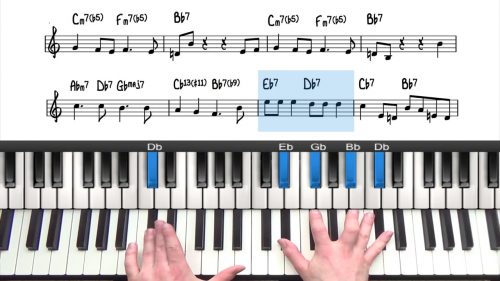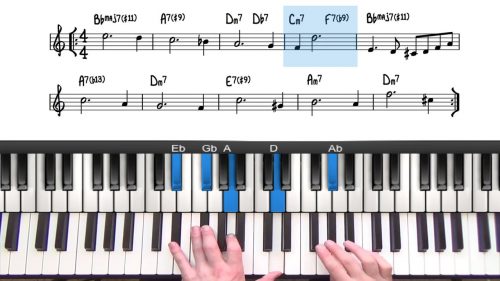Autumn Leaves Tutorial
In this lesson we’re going to look at the jazz standard ‘Autumn Leaves’.
Autumn Leaves is one of the best-known of all jazz standards and is frequently called at jam sessions so it’s a good idea to learn and memorise these important chord changes.
Usually played in the key of G Minor, the tune follows a 32 measure AABC form and contains both major and minor 251 progressions. The same 251s are repeated throughout which makes the form easy to memorise and fun to play over.
We’re going to start off with some simple two handed voicings so that we understand the chord changes and the harmonic movement through the tune.
We will then create both a slow tempo, ballad arrangement incorporating right hand scale runs and other fills.




Do you have any suggestions as to the fingering when you come down on the C dorian scale and then come down in 3rds? What finger is best to start with?
Hi Adam,
My main tips would be:
Try to avoid playing black notes with your thumb – this also applies to improvisation. When the thumb is on the black notes, it’s hard to get it back down again and it reduces the mobility in your hand. This isn’t set in stone but it helps to keep this in mind.
Further to step 1 – there are some ‘good starting points’ that help keep your thumb off the black notes, for example, I like to start with my index and 4th fingers on D and F (9 & 11 of C dorian), then play C and Eb with my thumb and 3rd finger, then play Bb and D with my index and 4th fingers. Then thumb and third again.
It’s basically just index and 4th alternating with thumb and 3rd finger. You will find that if you keep running down the scale like this, your thumb will land on a black note but if you are only playing over 1 bar of C-7 this shouldn’t be an issue.
Also try to avoid the pinky finger as it is inherently weaker than the others.
Any other questions let me know 🙂
Cheers, Hayden
Thank so kindly. I will give it a try.
Can you do a walking bass to go with the chords? It would be greatly appreciated.
Hi Adam. Yes sure thanks for the suggestion. I think a dedicated lesson on Walking Basslines would be best and then we can apply the theory to this tune and also some other standards. Leave it with me 🙂 Hayden.
Thank you
please explain about those upper structure traids you used in the ballad style arrangement after 6:08
ps. i have already seen upper structure video
Hi Samyak,
An upper structure triad is type of voicing… mainly used for dominant chords.
Upper structures voicings should be viewed in 2 parts:
First you have the “lower structure” of the chord which is played in the left hand. The lower structure is the root, 3rd and b7th of the dominant chord (the root is not essential – as in this example you will see that I just play the 3rd and b7th of the F7 in my left hand)
The lower structure should usually include both the 3rd and the b7th, although sometimes the root and b7 can sound nice…. it’s a matter of personal taste.
The we have the “upper structure” of the chord…. We build triads of certain scale degrees in order to access the extended and altered chord tones of the dominant chord.
For example, if you build a major triad of the 9th off any dominant chord, that triad will contain the 9th, #11th and 13th which gives you a dominant 13#11 sound. This is the chord we are playing in this lesson F13#11… we build a triad off the 9th of F7 (G Major triad) and that gives us the 9(G) #11(B) and the 13(D).
I would recommend that you check out the course on Altered Harmony & Upper Structure Triads: https://www.pianogroove.com/jazz-piano-lessons/altered-harmony-upper-structure-triads/
In the first lesson in that course, we start with some simple major 251 examples where we just alter 1 note in each chord. This is to get the student familiar with the individual alterations (there’s only 4 of them… b9, #9, #11 and #5/b13), This lesson will help you visualise these tones and also help you become familiar with the sound they create.
Then in lesson 3 of the course and onwards we introduce the concept of Upper Structure Triads. We first cover the theory, and then apply these voicings to a number of jazz standards.
If they are new to you, I think you will really enjoy studying the course… it will give you access to much richer, jazzier sounding dominant chords. It will really take your playing forwards Samyak so enjoy!
Let me know how you get on and if I can be of further assistance just let me know 🙂
Cheers,
Hayden
Hi Hayden. Few questions. Where can I learn more about Robarto(?) style of playing? Couldn’t find any info on it online. Also do you have a lesson on embellishing melodies? And a lesson on ways to build scale runs (such as the broken thirds technique you used). I guess it would be good practice to practice that broken thirds technique for all scale? Would like to know more techniques similar to that. Thanks!
Hi Kester,
Here is the wikipedia page for “Rubato” – https://en.wikipedia.org/wiki/Tempo_rubato – you could also search Google and YouTube for more answers.
For embellishing melodies, the best thing you can do is listen to a selection of recordings of the tunes you are working on, and then work out the embellishments using you ears. When we take the time to work out these embellishments by ear, they stick with us forever. The same applies to runs, fills, and any improvisation.
We do have a lesson on Autumn Leaves improvisation and melodic embellishment here: https://www.pianogroove.com/jazz-piano-lessons/autumn-leaves-bass-line-2/ – but remember that cannot replace working out fills and embellishments by ear from our favourite recordings.
In the foundations practice guide I outline a drill for practicing scales in different intervals: https://www.pianogroove.com/jazz-piano-lessons/foundations-practice-guide/ – check that out, I think you will find it useful 🙂
If you like the sound of harmonising scales in 3rds, then yes it would be a worthwhile exercise for you. It’s always important to apply to jazz standards, so perhaps when you see a similar situation in a jazz standard (where there is space in the melody and harmony) then simply try harmonising the scale with 3rds as a fill. That way it will feel like less of an exercise.
Bill Evans often used 3rd intervals for fills, improvisation, and melodic decoration. Listening to his recordings would be a great start and try to work out some of the fills he plays in this style. That would be my main piece of advice.
Hope this help and enjoy working on this stuff.
Cheers,
Hayden
Thank you!!
Can’t find the Autumn Leaves chord changes print out. When I try to download it, I get the transcription.
Hi Wendy 👋🏻
Thanks for letting me know about this.
When I click the button it gives me this file: https://www.pianogroove.com/wp-content/uploads/2017/06/Autumn_Leaves_Score.pdf
I will investigate further and please use the direct link above in the interim.
Cheers, Hayden
Hello Hayden,
first of all thanks so much for providing us with your jazz lessons that are really amazing!!!
Referring to the “Autumn Leaves” Transcription, I am struggling to find a plausible/good fingering for the measures 9 and 11. I am wondering if you have some suggestion/examples about that.
Thanks a lot for your time,
Cheers
Hello Hayden,
first of all thanks so much for providing us with your jazz lessons that are really amazing!!!
Referring to the “Autumn Leaves” Transcription, I am struggling to find a plausible/good fingering for the measures 9 and 11. I am wondering if you have some suggestion/examples about that.
Thanks a lot for your time,
Cheers
Hi Hayden, can you please explain in bar two of the the ballad style arrangement, the Cmin7. Why, and why it works the Eb maj7 arpeggio run.
Regards mark.
Hi Mark,
Great question.
Yes the C-7 works with an Ebmaj7 arpeggio run because the notes of Ebmaj7 are the 3, 5, 7, and 9 of C minor.
The Ebmaj7 contains the essential chord tones of C-7 (Eb and Bb which are the 3 and 7), the 5th, and also the 9th which is an extension or “colour tone”.
We must train ourselves to see that Ebmaj7 simply as 3-5-7-9 of C-7, or C-9, as we are just playing the tones of C minor.
I hope that helps and let me know if I can help further here.
Cheers, Hayden